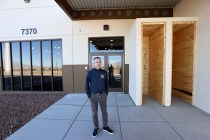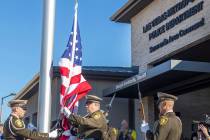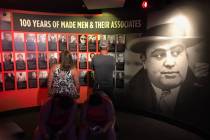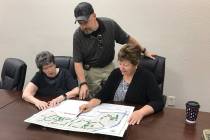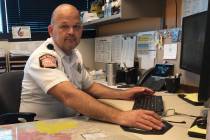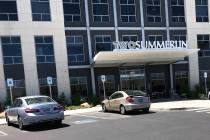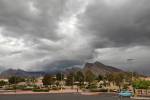Far Hills-215 bridge could be godsend to trail users
In case you haven’t noticed, there’s a pedestrian bridge that now straddles Far Hills Avenue, just west of the 215 Beltway. It wasn’t there as recently as a few weeks ago, and at first glance it appears that this beautiful walkway might be a bridge to nowhere.
But unlike Alaska’s proposed “bridge to nowhere,” which became the focal point of political brinksmanship five years ago, the bridge over Far Hills Avenue is an integral part of an entire section of the Summerlin and Southern Nevada recreational trail system.
Together with the 6 miles of paved and concrete trails that lead to and from the bridge, the cost of the project was put at $4 million, which is a mere pittance compared to the estimated $400 million of the Alaskan “bridge to nowhere” that was never built.
Instead, what we have here in Summerlin is an aesthetically inviting structure that is not only a bridge to somewhere, but of more consequence it will serve a meaningful purpose for the overwhelming number of walkers, joggers and bikers who live in Summerlin.
A poll conducted four years ago by The Howard Hughes Corp., the developer of Summerlin’s master plan, found that 89 percent of the community’s residents cited walking trails as Summerlin’s most important amenity.
“Trails rank well ahead of parks, golf courses and other recreational facilities in terms of both use and popularity among our residents,” Tom Warden said at the time of the survey. Warden is senior vice president of community and government relations for Hughes Corp.
“On any given day, thousands of Summerlin residents can be seen walking, running or cycling on the community’s trails,” he added.
At present, more than 150 miles of trails are entwined within the community — some of which connect from one neighborhood to another. When completed, Summerlin will have more than 200 miles for trail enthusiasts.
The contract for the Far Hills bridge and its 6 miles of extension, which runs across western Summerlin — almost parallel to the 215 Beltway — was approved by the city. Funding was obtained from the sale of federal lands, under terms of the Southern Nevada Public Lands Management Act. The law, enacted in 1998, already has produced more than $3 billion for various projects through the sale of public lands.
One provision of the act specifically calls for a portion of the funds to remain in “a special account available to the Secretary of the Interior,” to be used “for parks, trails and natural areas.”
City spokesman Jace Radke said “the 215-Far Hills bridge project allows for persons walking or biking the trail to continue without having to fight heavy traffic.” Realistically, it would be almost impossible to continue the trail without the bridge that sits above Far Hills Avenue.
“The Far Hills bridge is part of the loop trail that is being built around the outside of the city,” Radke said. The trail will eventually interlock with similar trails in North Las Vegas, other sectors of Las Vegas, unincorporated areas of Clark County and Henderson.
Outdoor recreation facilities, such as the network of trails, together with ideal weather conditions in Las Vegas and its environs, have for some time served as a major attraction for out-of-state homebuyers, just as the Hughes Corp. survey indicated. This resulted in the enactment of a Las Vegas 2020 master plan 13 years ago.
The plan was revised Feb. 20, when the City Council approved the extensive “City of Las Vegas Trail Elements” to be included in the 2020 master plan.
In explaining the city’s interest in establishing a network of trails, the revised document says, “the master plan contains numerous goals, objectives and policies pertaining directly and indirectly to trails. The trails element is intended to not only satisfy (statutory) requirements, but also provide a document that will assist with future needs of the city.”
The lengthy plan contains detailed maps and proposals for trails throughout the city. Summerlin, which is markedly ahead of the rest of the city in the construction of recreation trails, is referred to in only one paragraph:
“Trails proposed in Summerlin will be developed and maintained by The Howard Hughes Corp. and are not the responsibility of the city.”
Herb Jaffe was an op-ed columnist and investigative reporter for most of his 39 years at the Star-Ledger of Newark, N.J. His most recent novel, “Double Play,” is now available. Contact him at hjaffe@cox.net.








